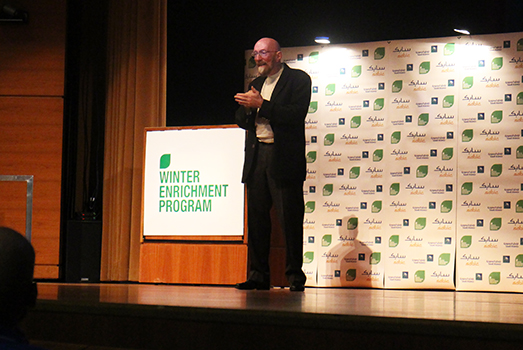Kip Thorne and the science of 'Interstellar'

World-renowned astrophysicist and theoretical physicist Kip Thorne speaks during WEP 2016 about his role as the lead scientific advisor for the 2014 Hollywood blockbuster “Interstellar.”
The second week of the University’s 2016 Winter Enrichment Program (WEP) program began with a look to the stars and to Hollywood, as world-renowned astrophysicist and theoretical physicist Kip Thorne spoke about his role as the lead scientific advisor for the 2014 Hollywood blockbuster “Interstellar” during a highly anticipated keynote address on January 17.
In 2006, Thorne and movie producer Lynda Obst conceived the underlying concepts for a science fiction movie that ultimately became “Interstellar.” The movie, which stars Matthew McConaughey and Anne Hathaway, deals with an uncertain fate for mankind, as humans must leave their dying home on Earth in search of other possibly habitable planets beyond our galaxy.
Thorne worked closely with Obst and writers Johnathan and Christopher Nolan to ensure that hard science was the backbone of the Nolan brothers’ vision for the movie. He also teamed with the movie’s visual effects team to ensure that black holes, wormholes and other astrophysical objects depicted were scientifically sound and plausible to his peers and the greater scientific community.
A crossroads between hard science and fiction
Throughout the talk, Thorne described his experience as man of science collaborating with filmmakers, artists, actors and composers as a role that sits at the crossroads between science and the arts. He detailed his theories and scientific findings as they were discussed, dissected and added to the framework that eventually became “Interstellar.”
Thorne noted how, at his first meeting with Christopher Nolan, who also directed the movie, Nolan stated, “I want a movie that ends as puzzlingly as Stanley Kubrick’s ‘2001: A Space Odyssey,’ but I want an ending that can be explained, and that’s where you [Thorne] come in.”
Nolan and Thorne’s collaboration did not always go smoothly, however. Thorne spoke freely about frank discussions and disagreements between the two as Nolan attempted to wrap his burgeoning vision around Thorne’s unwavering adherence to science.
A wide-ranging scope of deep science
“Interstellar” featured a large scope of deep science, including topics such as the design of Gargantua, the movie’s main black hole. Thorne discussed wormholes, tesseracts and gravitational waves, showing how his theories played a part in the movie’s final cut by playing clips of “Interstellar” to the audience.
“You can tell all of your friends and family that tonight at KAUST, you’ve been through wormholes, black holes and tesseracts,” KAUST President Jean-Lou Chameau stated at the close of the lecture. “I hope you appreciate the love that [Thorne] has for science and the passion he has for communicating science.”
- By David Murphy, KAUST News

